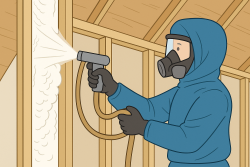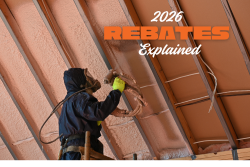You might have an insulation problem if you are paying high energy bills and your home doesn't feel warm enough this winter. You can resolve this issue by improving wall insulation. Furthermore, good wall insulation improves indoor air quality, reduces noise and enhances overall comfort. The benefits of enhanced wall insulation are numerous. Here are some tips on how to do it.
Stuffing Should Be Avoided
The solution to prevent heat loss from a poorly-insulated wall is not to stuff the insulation material. When you crumple batts so that they fit in narrow spaces, it generates uninsulated air pockets. Moreover, the R-value of closely packed insulation is also lower.
Use Spray Foam to Seal Narrow Gaps
Gaps cause heat loss, moisture and mould growth. Therefore, expanding spray foam is an ideal solution to fill in gaps efficiently. The foam material expands and seals the cavities in the walls, creating an airtight seal. As a result, the property is more energy-efficient since this seal prevents heat loss. Moreover, you can prevent air infiltration by sealing the space around the window with spray foam.
Wrap Insulation Around Pipes and Cables
Wrap the insulation material around the hot and cold water pipes after unrolling them. Wrapping pipes and cables with fibreglass insulation is an effective solution. Divide the batts to fit them around wires and pipes so you can get the full value of the insulation. You can easily tear open fibreglass batts for insulating around electrical cables because of their vertical weave.
Do Not Tuck Batts Behind Cables & Pipes
You should not stuff full-thickness batts behind pipes and cables because this can lead to insulation problems. When fibreglass is compressed, it loses its insulating properties, and voids appear between the insulation and the drywall.
Lay Batts Around Electrical Boxes
Avoid wrapping fibreglass batts around electrical boxes or stuffing full batts behind them. This will create gaps and air convection routes around the box. Instead, cut notches in the batts so that they will fit around electrical boxes. Typically, airtight boxes have gaskets that seal against the drywall to keep air out.
Fill Gaps with Foam
Use spray foam to seal around window and door jambs to prevent drafts. This 'minimal-expanding' type minimizes the possibility of warping the door frame. It is primarily intended to fill the space around the window and door to prevent air from entering. Once the foam has cured, lightly stuff the remaining space around the window with fibreglass insulation strips.
Wear Protective Equipment
Lastly, if you decide to install the insulation yourself, you should take the necessary safety measures. Ensure you protect your skin, eyes, and lungs when working with fibreglass. Installing a lot requires you to wear disposable coveralls, which you can get from paint stores and home centers. You can shield your skin from fibreglass irritants by wearing a dust mask, goggles, gloves, a cap, and long sleeves.
Check out our article on Blown-in Insulation: 6 Things You Should Know.
Even though you can insulate your walls on your own, a huge possibility is it will take a lot of your time and effort. Even so, it will not be as effective as professional quality insulation performed by a professional contractor. Therefore, hire a professional to do the job for long-term results. Consider spray foam insulation.
Reitzel Insulation has years of experience and skills in this industry. We can provide the right solutions for all your insulation needs in Kitchener-Waterloo and surrounding areas.

















